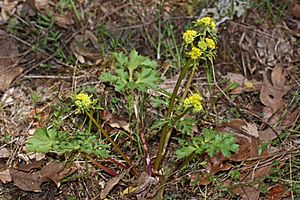Northern sanicle facts for kids
Quick facts for kids Northern sanicle |
|
|---|---|
 |
|
| Scientific classification | |
| Genus: |
Sanicula
|
| Species: |
graveolens
|
Sanicula graveolens is a type of flowering plant. It is often called northern sanicle or Sierra blacksnakeroot. This plant belongs to the Apiaceae family, which is also known as the carrot or parsley family.
You can find Sanicula graveolens growing in western North America. It grows from British Columbia down to Montana and California. It also lives in southern South America, including southern Chile. This plant likes to grow on mountain slopes, in forests, and in woodlands. It especially likes areas with serpentine soil, which is a special type of rocky soil.
Contents
About the Northern Sanicle Plant
The northern sanicle is a perennial plant. This means it lives for many years, not just one season. It is also an herb, so it has soft stems instead of woody ones like a tree.
Plant Structure and Growth
The plant grows a thin, branching stem that can reach about half a meter (about 20 inches) tall. This stem grows from a strong main root called a taproot, which goes straight down into the ground.
The leaves of the northern sanicle are arranged alternately along the stem. The lowest leaves have long stalks and sometimes grow partly underground. The leaves higher up on the stem are smaller and grow closer to the stem without long stalks.
Leaves and Color
Each leaf is made up of three smaller parts called leaflets. These leaflets have deep cuts and jagged edges, like teeth. The plant's leaves and stems can be green, or they might have a purple tint, or even be completely purple.
Flowers and Fruit
The flowers of Sanicula graveolens grow in clusters. These clusters are made up of tiny flowers with yellow petals that curve slightly. Some of these flowers have both male and female parts, while others are only male.
At the base of each flower cluster, there are narrow, toothed, leaf-like structures called bracts. After the flowers bloom, the plant produces small, round fruits. These fruits are only a few millimeters long and are covered in curving prickles. They grow in small groups on the plant.
See also
 In Spanish: Sanicula graveolens para niños
In Spanish: Sanicula graveolens para niños

